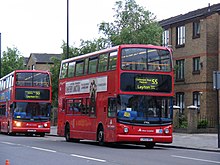Bulk formation
The formation of a coherent row of vehicles during the flow of traffic is called cluster formation .
Bulk formation through traffic lights
Bulk formation in public transport
Bulk formation (also: Nonius effect ) is a phenomenon that occurs in local public transport . By indirectly influencing trains, subways, buses, etc. traveling on the same route, fluctuations in the headway time tend to intensify ( positive feedback ): This means that vehicles after an extended headway time (or those already delayed) are more prone to delays , after Shortened headway times (or early ones), on the other hand, are more susceptible to prematurity .
Where such disruptions lead to strongly fluctuating vehicle headway times, the result is an uneven load on the vehicles used with passengers, with the consequence of differing passenger switching times . The result can be the creation of a crowd .
The description as a vernier effect occurs because of the analogy to the vernier in the measuring technology, a similar effect to increase the accuracy of measuring instruments for measurement of lengths and angles used.
- example
In line with this, for example, on a railway line on which trains travel together and whose cycle schedules are different (e.g. every 15 minutes line 1 runs, every 20 minutes line 2), disruptions can occur after some time. The timetable gets mixed up.
Line 1 with a cycle time of 15 min → vehicle comes to minute 0/15/30/45
Line 2 with a cycle time of 20 min → vehicle comes to minute 7/27/47
this results in the headway times → 7/8/12/3/15/2/13
ITCS operations control systems can reduce this effect by informing the drivers of existing schedule deviations so that they can influence the time intervals.
Individual evidence
- ↑ mrieser: "The vehicles run at irregular intervals". (No longer available online.) In: senozon.com. 2012, archived from the original on July 14, 2012 ; accessed on September 4, 2018 .
